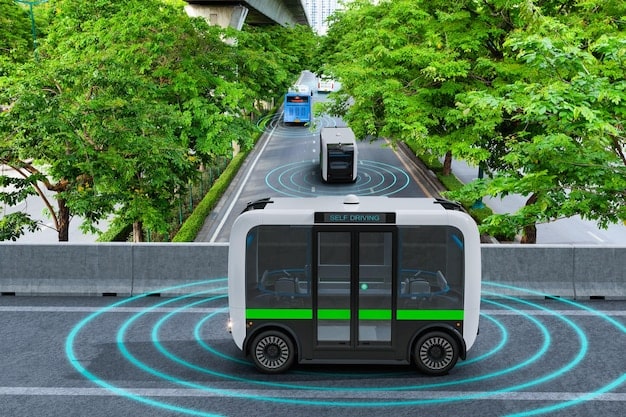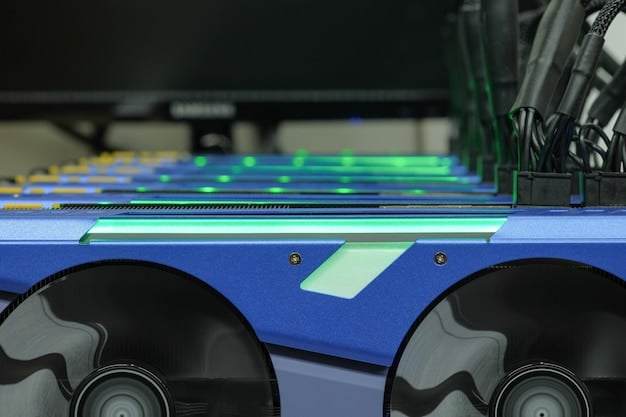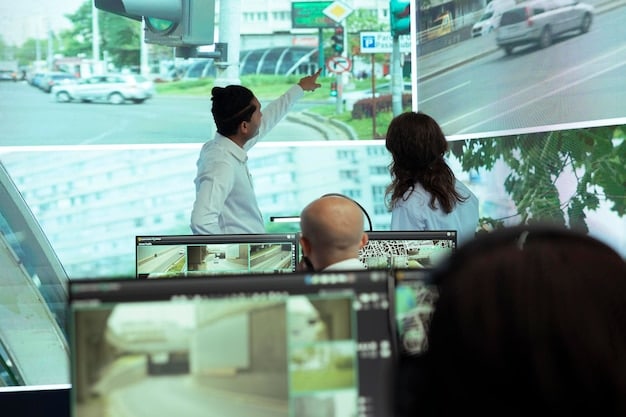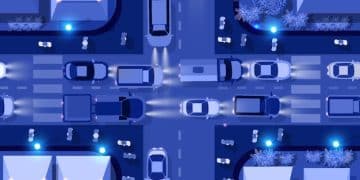Analyzing the Impact of New Regulations on Autonomous Vehicles in the US

Analyzing the Impact of New Regulations on Autonomous Vehicle Testing and Deployment in the US involves examining how new rules affect the development, testing, and introduction of self-driving cars, potentially influencing safety standards, technological advancements, and market readiness.
The landscape of autonomous vehicles (AVs) in the United States is rapidly evolving, with continuous advancements in technology and increasing public interest. However, the safe and responsible integration of AVs into our transportation systems hinges on robust regulatory frameworks. Analyzing the Impact of New Regulations on Autonomous Vehicle Testing and Deployment in the US is crucial for understanding the future of this transformative technology.
Understanding the Current Regulatory Landscape for AVs
The regulation of autonomous vehicles in the US is a complex patchwork of federal and state laws. Currently, there is no single federal agency overseeing all aspects of AV development and deployment, leading to a fragmented regulatory environment.
Federal Guidelines and Standards
At the federal level, the National Highway Traffic Safety Administration (NHTSA) plays a central role. NHTSA has issued voluntary guidelines for AV development, focusing on safety and performance standards. These guidelines, while not legally binding, provide a framework for manufacturers to follow.
State-Level Regulations
States have taken varying approaches to AV regulation. Some states have enacted comprehensive laws addressing testing and deployment, while others have adopted a more cautious approach, focusing on safety concerns and liability issues.
- California: A leader in AV testing and deployment, California has detailed regulations governing the operation of autonomous vehicles on public roads.
- Arizona: Known for its permissive regulatory environment, Arizona has attracted significant AV testing and development activities.
- Texas: Texas has also emerged as a key state for AV testing, with regulations that balance innovation and safety.

The current regulatory landscape reflects an ongoing effort to balance innovation with safety. As AV technology continues to advance, it is likely that regulations will evolve to address new challenges and opportunities.
Key Areas Impacted by New AV Regulations
New regulations on autonomous vehicles can have a wide-ranging impact on various aspects of the industry. These impacts can affect manufacturers, technology developers, and the public alike.
Testing and Validation Requirements
Stricter testing and validation requirements may be introduced to ensure the safety and reliability of AVs. This could include more rigorous simulation testing, real-world driving scenarios, and independent verification processes.
Data Collection and Privacy
Regulations may address the collection, storage, and use of data generated by AVs. This could involve requirements for data anonymization, transparency, and user consent to protect privacy.
Cybersecurity Standards
As AVs become more connected, cybersecurity becomes a paramount concern. New regulations may mandate specific cybersecurity measures to prevent hacking and protect vehicle systems from malicious attacks.
The introduction of new regulations can lead to both challenges and opportunities for the AV industry. Companies may need to invest more in compliance efforts, but clear and well-defined rules can also foster public trust and accelerate the adoption of AV technology.
The Economic Implications of AV Regulations
The development and deployment of autonomous vehicles have significant economic implications, and regulations play a crucial role in shaping these outcomes. The regulations can drive innovation, investment, and job creation within the AV sector.
Impact on Research and Development
Stringent safety standards may push AV companies to invest more in research and development to improve their technologies. These might include the development of more advanced sensor systems, artificial intelligence algorithms, and fail-safe mechanisms.
Job Creation and the Workforce
The AV industry has the potential to create numerous jobs in various fields, including engineering, software development, data analysis, and manufacturing. Regulations supporting AV deployment may foster the growth of these job markets.

Market Competition and Innovation
A fair regulatory environment can promote competition among AV companies, encouraging innovation and driving down costs. This could lead to a wider range of AV products and services becoming available to consumers.
Ultimately, the economic implications of AV regulations depend on striking a balance between promoting innovation and ensuring safety and consumer protection. Regulations should be flexible enough to adapt to technological advancements while providing a clear framework for industry participants.
Safety and Ethical Considerations in AV Regulation
Safety is the foremost concern in autonomous vehicle regulation. Ensuring that AVs operate safely and reliably is essential for public acceptance and widespread adoption.
Defining Safety Standards
Regulations must clearly define what constitutes acceptable safety performance for AVs. This could include metrics such as accident rates, response times in emergency situations, and performance in adverse weather conditions.
Addressing Ethical Dilemmas
AVs may face ethical dilemmas in certain scenarios, such as unavoidable accident situations. Regulations may need to provide guidance on how AVs should be programmed to make decisions in these complex situations.
Human-Machine Interaction
The interaction between humans and AVs is another critical safety consideration. Regulations may address issues such as driver training, handover protocols, and the design of user interfaces.
By addressing these safety and ethical considerations, regulations can help build public trust in AV technology and pave the way for its safe and responsible integration into our society.
International Comparisons of AV Regulations
Different countries are taking different approaches to regulating autonomous vehicles. Comparing these approaches can provide valuable insights and best practices.
European Union
The European Union is developing a comprehensive regulatory framework for AVs, focusing on safety, cybersecurity, and data privacy. The EU aims to create a harmonized set of rules that facilitate the cross-border operation of AVs.
China
China has also emerged as a major player in the AV industry, with strong government support and a large domestic market. China’s regulations prioritize safety and cybersecurity, with a focus on promoting domestic innovation.
Japan
Japan has adopted a more incremental approach to AV regulation, focusing on specific use cases such as autonomous shuttles and delivery vehicles. Japan’s regulations emphasize collaboration between government, industry, and academia.
By comparing these international approaches, the US can learn from other countries’ experiences and develop regulations that are both effective and conducive to innovation.
The Future of AV Regulation in the US
The future of AV regulation in the US is likely to involve a greater degree of harmonization and coordination between federal and state authorities. As AV technology continues to mature, regulations will need to adapt to address new challenges and opportunities. Regulations also need to be flexible enough to evolve with the technology, allowing innovation to flourish while protecting public safety and privacy.
Potential for Federal Legislation
There is growing support for federal legislation to establish a unified regulatory framework for AVs. Such legislation could streamline the regulatory process, reduce uncertainty for industry participants, and promote consistency across states.
Role of Public-Private Partnerships
Public-private partnerships can play a crucial role in shaping the future of AV regulation. Collaborations between government agencies, AV companies, and research institutions can facilitate the development of best practices and standards.
Evolving Regulatory Priorities
As AV technology becomes more prevalent, regulatory priorities may shift from testing and development to deployment and operation. This could involve addressing issues such as insurance liability, traffic management, and infrastructure planning.
| Key Aspect | Brief Description |
|---|---|
| 🛡️ Safety Standards | New regulations may enforce stricter safety standards for AV testing and deployment. |
| 📊 Data Privacy | Regulations address data collection and privacy, including anonymization and user consent. |
| 💼 Economic Impact | Regulations influence R&D, job creation, and market competition in the AV industry. |
| 🌎 International Comparison | The US can learn from EU, China, and Japan regading autonomous vehicles. |
Frequently Asked Questions
▼
Currently, the National Highway Traffic Safety Administration (NHTSA) provides voluntary guidelines focusing on safety and performance standards. These are not legally binding but offer a framework for manufacturers.
▼
Some states like California have detailed regulations, while others such as Arizona have more permissive environments. This variance impacts where and how AV companies conduct their tests.
▼
Ethical considerations include how AVs should be programmed to handle unavoidable accident situations, balancing safety with other factors. Regulations might provide guidance on decision-making in such cases.
▼
The EU is developing harmonized rules for cross-border AV operation, while China focuses on domestic innovation. Japan emphasizes collaboration. The US can learn from these diverse approaches.
▼
There is growing support for federal legislation to create a unified AV regulatory framework. This could streamline processes, reduce uncertainty, and promote consistency across different states in the US.
Conclusion
In conclusion, analyzing the impact of these regulations on autonomous vehicle testing and deployment in the US is crucial for guiding strategy and policy within the auto industry. As these vehicles become more sophisticated and regulations evolve, staying informed is pivotal for successful innovation and integration.





